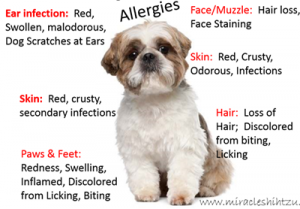How Can Allergies Be Treated?

In order to treat allergies, one of the first things that ideally needs to be done is to identify what the dog is actually allergic to (intradermal skin testing). Once the source of the allergy has been identified, it may then be possible to either eliminate the substance or work to reduce the dog’s sensitivity.
If the dog is allergic to fleas, start a flea control programme before the season starts.
If dust is the problem, clean the dog’s bedding once a week and vacuum at least twice a week, including rugs, curtains and any other materials that gather dust.
For dust mites, use a plastic cover over the dog’s bed and avoid letting the dog sleep on stuffed furniture. Avoid soft toys. Keep dogs in uncarpeted rooms. Avoid dusty pet foods.
Weekly bathing may help to remove environmental allergens and pollens from the skin – ideally use either a hypoallergenic dog shampoo or colloidal oatmeal shampoo. Also wearing protective T-shirts / jackets can protect the body from environmental allergies when out on a walk. Also, keep dogs inside when the lawn is mowed and avoid large numbers of houseplants.
For food allergies, an elimination diet should be considered (much easier if feeding raw or home-cooked, as ingredients can be more easily controlled).
However, some allergens cannot be easily removed from the dog’s environment and in this case the dog may need to be treated for the symptoms rather than the cause. Antihistamines or a short course of corticosteroids may help in this case – although note:
Antihistamines are only effective in around 30% of allergies in dogs, and every animal will respond differently to each of the different antihistamines. And every antihistamine has a different dose and risk of side effect – some common side effects include sedation, hyperactivity, constipation, dry mouth and inappetence.
Corticosteroid drugs are strong and should be used with caution (they can cause liver problems and in older dogs can trigger a form of Cushing’s disease). Steroids increase appetite and thirst, and can cause depression or increase aggression in some dogs. The goal with all steroids is to use the minimum dose necessary to alleviate the symptoms. If fatty acids and antihistamines are used concurrently with steroids then the amount of steroids needed to offer relief should be greatly reduced.
Allergy injections can also be given to help the dog develop resistance to the offending agent, or an immune modulating drug may be helpful. Before having these allergy injections (immunotherapy), the antigens that the dog is allergic to must have been identified and an appropriate injection prepared using altered antigens. A series of weekly or monthly shots are given, depending on the product used. Success can be as high as 80%. It is used mainly where symptoms are present for more than 4-6 months of the year, and fatty acids and antihistamines do not provide satisfactory results.
Topical solutions containing hydrocortisone offer some relief for localised itching. Creams or salves can be used on the feet and between the toes, and sprays on the abdomen and other areas with less hair. These products are very poorly absorbed into the bloodstream when used in moderation, and do not create the long-term side effects or problems associated with injectable or oral steroids. Coolling salves and lotions can also be used, but take care to ensure they do not make the coat too greasy and the dog does not lick them off the coat.
One way to relieve allergies naturally is to feed a diet rich in antioxidants – these come in many forms and can be found in berries, green leafy vegetables, apples, chlorella, spirulina (ideally from Australia or Hawaii, not from China), moringa leaf, olive leaf, kelp, raw meat and organic organ meats (particularly liver). A raw meat based diet is the ultimate in providing a high antioxidant diet.
Calendula is a well-known herb that can reduce itching and inflammation, calming the itch, and promote quick healing of skin tissue
The use of high doses of Vitamin C can help dogs with suppressed immune function – Vitamin C helps to stabilise mast cells so they are less likely to release histamine and other allergy mediating chemicals. In difficult cases of allergic inflammation Vitamin C can be given to bowel tolerance.
Fatty acid supplements (particularly Omega-3) can help to reduce the amount and effects of histamine and other chemicals that are released in response to allergies and they help keep the skin supple and healthy. However, not all allergic dogs respond to fatty acid supplements. There are also shampoos that may help prevent skin infection, and sprays containing oatmeal, aloe and other natural products are also available.
Digestive enzymes can also reduce inflammation. These can be fed with meals to aid digestion and feed beneficial bacteria. However, it is important not to supplement with digestive enzymes if the intestinal flora is out of balance.
Biotin is one of the B vitamins, and several studies have shown that supplementing daily with it helps dogs suffering from dry skin, seborrhea, and dry, itchy allergic skin. It is often used in combination with fatty acids to treat dogs suffering from allergies. Biotin can be fed as a supplement on its own, or as a component of brewer’s yeast.
One important contribution factor to allergies is an unbalanced intestinal flora. When dogs are given antibiotics, fed an improper diet or exposed to bacteria and viruses the intestinal flora can become unbalanced, with the bad bacteria overcrowding the good bacteria. A good quality probiotic such as Kefir will help to restore the proper intestinal flora.
